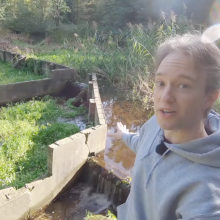In 2013 Shell had to transport an eight-story metal building from Rotterdam to Amsterdam.
They hired a company called The Timewriters to create a time-lapse video of the transport, which has now been released in glorious 4K format on YouTube, accompanied by a beautiful, if somewhat ill-fitting Dvořák piece.
The day-long journey begins on the Nieuwe Maas river near the Feijenoord neighbourhood in Rotterdam, then goes past Gouda, Alphen aan de Rijn and Schiphol Airport to end in Amsterdam. If it hadn’t been dark by then, you might even have been able to see my house at 9:14.
This is worth watching for the bridges alone.
And then you come back a second time for the places you know and a third time to figure out how and why the Dutch created their environment the way they did.
Also check out the comments on YouTube, lots of insights from people who recognise certain types of trains, planes and places.
(Source: YouTube / The Timewriters)

 YouTuber Tom Scott visited the Waterloopbos in Marknesse in the Noordoostpolder and had a little chat with Leo van Rijn, a specialist in modelling the flow of watercourses.
YouTuber Tom Scott visited the Waterloopbos in Marknesse in the Noordoostpolder and had a little chat with Leo van Rijn, a specialist in modelling the flow of watercourses.
 ‘Room for the River’ is a Dutch state project that intends to widen the floodplains of the major rivers.
‘Room for the River’ is a Dutch state project that intends to widen the floodplains of the major rivers.  Last Friday a diver of the Schoonhoven fire department saved millions of Dutch people a few jittery hours when he put his foot against the wall of a ship carrying coffee to stop water from flowing in.
Last Friday a diver of the Schoonhoven fire department saved millions of Dutch people a few jittery hours when he put his foot against the wall of a ship carrying coffee to stop water from flowing in.